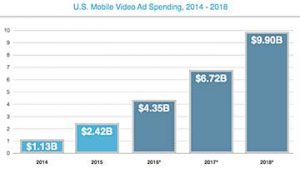The role of in-app advertising is changing.
It has to change. For a long time the dominant app model was “pay-once to play”, where the user forked over money up front and was never presented with in-app advertising at all. As more free-to-download apps enter the market new revenue-generating models had to come along with them. These new revenue models have been a boon for in-app advertising, which now represents about 72% of all total mobile ad spending. In-app ads beat out the alternatives tremendously as research has shown that mobile users spend 88% of time in-app, far beyond the amount of time users spend in mobile browsers.
Here are some trends that have presented themselves as the in-app advertising space has matured:
Video
Likely not a surprise that video would be a trend in any mobile area for 2017. Look at the growth of mobile video ads:

While mobile video ads are on the rise, the “Vendor Carnival” problem is on the rise with it. There are an overwhelming number of different vendors and options available for in-app advertising and in-app video advertising, and because their solutions can only slightly differ advertisers can struggle to find the right combination.
The struggle is worth it though. Most effective marketing involves analyzing multiple channel performance and reducing spend on underperforming channels; as a result, more companies are navigating to in-app video advertising as a potential for positive ROI. That growth in video will only continue in 2017.
Chatbots
Chatbots have been on the rise for years now, a trend that’s unlikely to end any time soon. Integrating a purchase process into in-app messaging can yield positive results for the brand-customer relationship, in large part because of the ease and accessibility of the process.
This process is so easy and accessible that Huffington Post recently argued that we are in the middle of a “a farewell to ads,” If people are (1) already on their phone, (2) already on a messaging platform, and (3) can buy directly through there as a form of in-app advertising, this “farewell to ads” does make some sense. This doesn’t mean that ads will disappear completely — it means chatbots will take a much more prominent role in promoting products and services.
The Bottom Line
In-app mobile advertising is likely to continue to grow as a driver of total app revenue, which will exceed $100 billion in three years. As mobile-first becomes the norm across the world, in-app advertising will continue to expand its reach and growth for mobile marketers.
What’s more, despite misconceptions about cookies (mobile is a cookie-less channel, and cookies were a gold standard of tracking users for years on desktop), there are increasingly ways for in-app advertising to deliver user data and audience targeting back to the advertisers. As that functionality continues to evolve in 2017 and beyond, we’ll likely see even more adoption of in-app advertising.
Want to find out more? Contact us.

